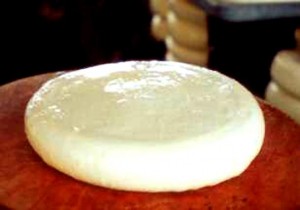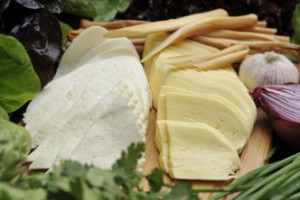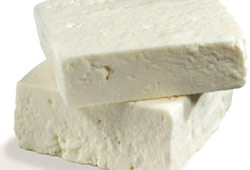Suluguni
Suluguni is a semi-hard pickled cheese produced in Georgia, more specifically in the Samegrelo region. It has many delicious recipes to its credit and is widely used in various cuisines. Read this article to know more about this cheese, its production, nutritional value and recipes.

Suluguni
Table Of Content
Suluguni Production
It is produced from cow, buffalo, goat, or sheep milk. It can also be produced from a mixture of these.
Know about the steps that go into the manufacture of this cheese.
- The milk and the bacterial starter are first mixed together. This mixture is then scalded at a temperature between 36 and 38°C. It is sometimes curdled with rennet and not scalded.
- After scalding, it is turned into a hard, smooth-textured cheese through cheddaring in whey at a lower temperature (34-35 °C) for at least five hours. This process continues until the Titratable acidity of the mixture reaches somewhere within 140-160°T.
- The resultant product is then cut into pieces within 1 to 3 cm. These pieces are heated in a Rotating Mixer at 60 to 80 °C. It takes a few minutes to make the cheese moldable.
- Whey is then drained off the cheese and the latter is given shape by hand. The final product is kept in mildly acidic brine at 8 to12°C for 6 to 48 hours.
Shape and Color of Suluguni Cheese
This cheese usually has the shape of a flat disc. The average thickness of the disc is 2.5- 3.5 cm. The color of this substance varies from white to pale yellow.
 Picture 1 – Suluguni Cheese
Picture 1 – Suluguni Cheese
Source – sancho.dq.am
Taste of Suluguni Cheese
This semi-solid cheese has a milky taste which is mildly sour with a hint of saltiness. It is regarded as the finest salted cheese. It also has a dimpled texture.
This product is usually deep fried. This suppresses its odor which is much less appealing compared to its great flavor.
Suluguni Nutritional Facts
It can be a nutritional food if consumed in a moderate amount. The average dry fat content of this product is 45%. It also contains 50% water and 1 to 5% salt in its total weight which is somewhere between 0.5 to 1.5 kg.
100 gm of this cheese approximately contains:
- Fat: 24 gm
- Protein: 24 gm
- Carbohydrate: 2 gm
Energetic value of the same amount is 295 cal.
 Picture 2 – Suluguni Image
Picture 2 – Suluguni Image
Source – en.wikipedia.org
Uses and Recipes of Suluguni
It is a very popular ingredient in Russian cuisine. There are numerous Suluguni cheese recipes that are immensely popular around the world. The most important recipe of this milk product is the “Khachapuri”, a type of Georgian cheese bread. Some other recipes of this milk product are:
- Fried Suluguni Cheese
- Grilled Cheese
- Vegetable Salads
Suluguni Substitute
The Mozzarella cheese can be a fine substitute for this cheese.
Suluguni Shelf Life
It should be stored at a temperature between -4 and 0 °C and the relative humidity should be 85- 90%. This will keep it fresh for three months starting from the date of manufacturing. It can also be stored at a temperature of 0- 6 °C and relative humidity of 80- 85%.
It is a pure milk product with a great taste and flavor. This explains why it is so popular and is entitled as the most delicious salted cheese.
Suluguni Pictures
Here are some pictures of Suluguni Cheese:
 Picture – Sulugni Photo
Picture – Sulugni Photo
Source – g2go.ru
Picture 4 – Suluguni Picture
Source – cheddar.ru
References:
https://www.cheese.com/sulguni/
https://www.delightedcooking.com/what-is-suluguni.htm
https://www.fondazioneslowfood.com/en/ark-of-taste-slow-food/sulguni-cheese/
- by Deepamala Bhattacharya
- September 13th 2011

















Leave a Reply